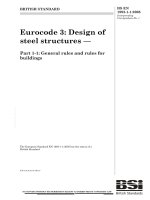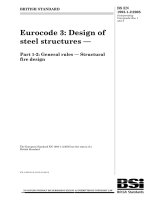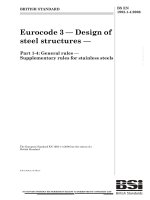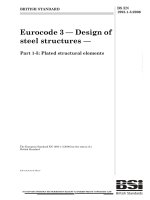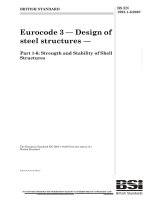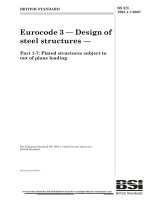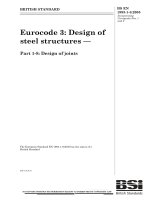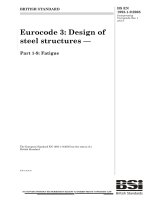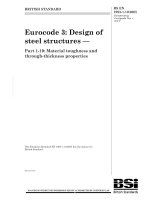Tiêu chuẩn Châu Âu EC6: Kết cấu gạch đá phần 3: Phương pháp đơn giản hóa (Eurocode6 BS EN 1996 3 Design of masonry structures part 3: Simplified calculation methods for unreinforced masonry structures)
Bạn đang xem bản rút gọn của tài liệu. Xem và tải ngay bản đầy đủ của tài liệu tại đây (576.95 KB, 46 trang )
BRITISH STANDARD
Eurocode 6 — Design of
masonry structures —
Part 3: Simplified calculation methods
for unreinforced masonry structures
The European Standard EN 1996-3:2006 has the status of a
British Standard
ICS 91.010.30; 91.080.30
12 &23<,1* :,7+287 %6, 3(50,66,21 (;&(37 $6 3(50,77(' %< &23<5,*+7 /$:
BS EN
1996-3:2006
BS EN 1996-3:2006
National foreword
This British Standard is the official English language version of
EN 1996-3:2006. It supersedes DD ENV 1996-3:2001 which is withdrawn.
The structural Eurocodes are divided into packages by grouping Eurocodes for
each of the main materials, concrete, steel, composite concrete and steel,
timber, masonry and aluminium. This is to enable a common date of
withdrawal (DOW) for all the relevant parts that are needed for a particular
design. The conflicting national standards will be withdrawn at the end of the
co-existence period, after all the EN Eurocodes of a package are available.
Following publication of the EN, there is a period of two years allowed for the
national calibration period during which the national annex is issued, followed
by a three year co-existence period. During the co-existence period Member
States will be encouraged to adapt their national provisions to withdraw
conflicting national rules before the end of the co-existence period. The
Commission in consultation with Member States is expected to agree the end
of the co-existence period for each package of Eurocodes.
At the end of this co-existence period, the national standard will be withdrawn.
In the UK, the corresponding national standards are:
— BS 5628-1:1992, Code of practice for use of masonry. Structural use of
unreinforced masonry
— BS 5628-2:2000, Code of practice for use of masonry. Structural use of
reinforced and prestressed masonry
— BS 5628-3:2001, Code of practice for use of masonry. Materials and
components, design and workmanship
and based on this transition period, these standards will be withdrawn on a
date to be announced.
Summary of pages
This document comprises a front cover, an inside front cover, page i, a blank
page, the EN title page, pages 2 to 40, an inside back cover and a back cover.
The BSI copyright notice displayed in this document indicates when the
document was last issued.
Amendments issued since publication
This British Standard was
published under the authority
of the Standards Policy and
Strategy Committee
on 15 February 2006
© BSI 15 February 2006
ISBN 0 580 47821 1
Amd. No.
Date
Comments
BS EN 1996-3:2006
The UK participation in its preparation was entrusted by Technical Committee
B/525, Building and civil engineering structures, to Subcommittee B/525/6, Use
of masonry, which has the responsibility to:
—
aid enquirers to understand the text;
—
present to the responsible international/European committee any
enquiries on the interpretation, or proposals for change, and keep UK
interests informed;
—
monitor related international and European developments and
promulgate them in the UK.
A list of organizations represented on this subcommittee can be obtained on
request to its secretary.
Where a normative part of this EN allows for a choice to be made at the national
level, the range and possible choice will be given in the normative text, and a note
will qualify it as a Nationally Determined Parameter (NDP). NDPs can be a
specific value for a factor, a specific level or class, a particular method or a
particular application rule if several are proposed in the EN.
To enable EN 1996-1-1 to be used in the UK, the NDPs will be published in a
National Annex, which will be made available by BSI in due course, after public
consultation has taken place.
Cross-references
The British Standards which implement international or European publications
referred to in this document may be found in the BSI Catalogue under the section
entitled “International Standards Correspondence Index”, or by using the
“Search” facility of the BSI Electronic Catalogue or of British Standards Online.
This publication does not purport to include all the necessary provisions of a
contract. Users are responsible for its correct application.
Compliance with a British Standard does not of itself confer immunity
from legal obligations.
i
blank
EUROPEAN STANDARD
EN 1996-3
NORME EUROPÉENNE
EUROPÄISCHE NORM
January 2006
ICS 91.010.30; 91.080.30
Supersedes ENV 1996-3:1999
English Version
Eurocode 6 - Design of masonry structures - Part 3: Simplified
calculation methods for unreinforced masonry structures
Eurocode 6 - Calcul des ouvrages en maçonnerie - Partie
3: Méthodes de calcul simplifiées pour les ouvrages en
maçonnerie non armée
Eurocode 6 - Bemessung und Konstruktion von
Mauerwerksbauten - Teil 3: Vereinfachte
Berechnungsmethoden für unbewehrte Mauerwerksbauten
This European Standard was approved by CEN on 24 November 2005.
CEN members are bound to comply with the CEN/CENELEC Internal Regulations which stipulate the conditions for giving this European
Standard the status of a national standard without any alteration. Up-to-date lists and bibliographical references concerning such national
standards may be obtained on application to the Central Secretariat or to any CEN member.
This European Standard exists in three official versions (English, French, German). A version in any other language made by translation
under the responsibility of a CEN member into its own language and notified to the Central Secretariat has the same status as the official
versions.
CEN members are the national standards bodies of Austria, Belgium, Cyprus, Czech Republic, Denmark, Estonia, Finland, France,
Germany, Greece, Hungary, Iceland, Ireland, Italy, Latvia, Lithuania, Luxembourg, Malta, Netherlands, Norway, Poland, Portugal, Romania,
Slovakia, Slovenia, Spain, Sweden, Switzerland and United Kingdom.
EUROPEAN COMMITTEE FOR STANDARDIZATION
COMITÉ EUROPÉEN DE NORMALISATION
EUROPÄISCHES KOMITEE FÜR NORMUNG
Management Centre: rue de Stassart, 36
© 2006 CEN
All rights of exploitation in any form and by any means reserved
worldwide for CEN national Members.
B-1050 Brussels
Ref. No. EN 1996-3:2006: E
EN 1996-3:2006 (E)
Contents
Background of the Eurocode programme......................................................................................... 4
Status and field of application of Eurocodes..................................................................................... 5
National Standards implementing Eurocodes .................................................................................. 6
Links between Eurocodes and harmonised technical specifications (ENs and ETAs) for
products. ................................................................................................................................... 6
National Annex for EN 1996-3 ........................................................................................................... 7
1
General ..................................................................................................................................... 8
1.1
Scope Part 3 of Eurocode 6..................................................................................................... 8
1.2
Normative references .............................................................................................................. 8
1.3
Assumptions ............................................................................................................................. 8
1.4
Distinction between Principles and Application Rules ........................................................ 8
1.5
Definitions................................................................................................................................. 9
1.5.1 General ..................................................................................................................................... 9
1.5.2 Masonry.................................................................................................................................... 9
1.6
Symbols..................................................................................................................................... 9
2
2.1
2.2
2.3
Basis of design ........................................................................................................................ 10
General ................................................................................................................................... 10
Basic variables........................................................................................................................ 10
Verification by the partial factor method ........................................................................... 10
3
3.1
3.2
3.3
3.4
Materials................................................................................................................................. 11
General ................................................................................................................................... 11
Characteristic compressive strength of masonry ............................................................... 11
Characteristic flexural strength of masonry ....................................................................... 11
Characteristic initial shear strength of masonry................................................................ 11
4
Design of unreinforced masonry walls using simplified calculation methods ................. 12
4.1
General ................................................................................................................................... 12
4.2
Simplified calculation method for walls subjected to vertical and wind loading ............ 12
4.2.1 Conditions for application .................................................................................................... 12
4.2.2 Determination of design vertical load resistance of a wall ................................................ 15
4.3
Simplified calculation method for walls subjected to concentrated loads........................ 18
4.4
Simplified calculation method for shear walls .................................................................... 19
4.4.1 Verification of shear resistance of walls .............................................................................. 19
4.4.2 Design shear resistance ......................................................................................................... 20
4.5
Simplified calculation method for basement walls subject to lateral earth
pressure................................................................................................................................... 21
4.6
Simplified calculation method for the design of walls subjected to limited lateral
load but no vertical loads ...................................................................................................... 22
4.7
Simplified calculation method for the design of walls subjected to uniform lateral
load but no vertical loads ...................................................................................................... 22
2
EN 1996-3:2006 (E)
Annex A (Informative) Simplified calculation method for unreinforced masonry walls of
buildings not greater than 3 storeys..................................................................................... 23
Annex B (Normative) Simplified calculation method for the design of internal walls not
subject to vertical loads and with limited lateral load ....................................................... 26
Annex C (Informative) Simplified calculation method for the design of walls subjected to
uniform lateral design load and no vertical loads .............................................................. 30
Annex D (Normative) Simplified method of determining the characteristic strength of
masonry .................................................................................................................................. 35
3
EN 1996-3:2006 (E)
Foreword
This European Standard EN 1996-3 has been prepared by Technical Committee CEN/TC 250 “Structural
Eurocodes”, the secretariat of which is held by BSI.
This European Standard shall be given the status of a national standard, either by publication of an
identical text or by endorsement, at the latest by July 2006, and conflicting national standards shall
be withdrawn at the latest by March 2010.
CEN/TC 250 is responsible for all Structural Eurocodes.
This document supersedes ENV 1996-3:1999
According to the CEN/CENELEC Internal Regulations, the national standards organizations of the
following countries are bound to implement this European Standard: Austria, Belgium, Cyprus,
Czech Republic, Denmark, Estonia, Finland, France, Germany, Greece, Hungary, Iceland, Ireland,
Italy, Latvia, Lithuania, Luxembourg, Malta, Netherlands, Norway, Poland, Portugal, Romania,
Slovakia, Slovenia, Spain, Sweden, Switzerland and United Kingdom.
Background of the Eurocode programme
In 1975, the Commission of the European Community decided on an action programme in the field
of construction, based on article 95 of the Treaty. The objective of the programme was the
elimination of technical obstacles to trade and the harmonisation of technical specifications.
Within this action programme, the Commission took the initiative to establish a set of harmonised
technical rules for the design of construction works which, in a first stage, would serve as an
alternative to the national rules in force in the Member States and, ultimately, would replace them.
For fifteen years, the Commission, with the help of a Steering Committee with Representatives of
Member States, conducted the development of the Eurocodes programme, which led to the first
generation of European codes in the 1980s.
In 1989, the Commission and the Member States of the EU and EFTA decided, on the basis of an
agreement1 between the Commission and CEN, to transfer the preparation and the publication of
the Eurocodes to the CEN through a series of Mandates, in order to provide them with a future
status of European Standard (EN). This links de facto the Eurocodes with the provisions of all the
Council’s Directives and/or Commission’s Decisions dealing with European standards (e.g. the
Council Directive 89/106/EEC on construction products -CPD- and Council Directives 93/37/EEC,
92/50/EEC and 89/440/EEC on public works and services and equivalent EFTA Directives initiated
in pursuit of setting up the internal market). The Structural Eurocode programme comprises the
following standards generally consisting of a number of Parts:
1 Agreement between the Commission of the European Communities and the European Committee for Standardisation
(CEN) concerning the work on Eurocodes for the design of building and civil engineering works (BC/CEN/03/89).
4
EN 1996-3:2006 (E)
EN 1990, Eurocode: Basis of structural design .
EN 1991, Eurocode 1: Actions on structures.
EN 1992, Eurocode 2: Design of concrete structures.
EN 1993, Eurocode 3: Design of steel structures.
EN 1994, Eurocode 4: Design of composite steel and concrete structures.
EN 1995, Eurocode 5: Design of timber structures.
EN 1996, Eurocode 6: Design of masonry structures.
EN 1997, Eurocode 7: Geotechnical design.
EN 1998, Eurocode 8: Design of structures for earthquake resistance.
EN 1999, Eurocode 9: Design of aluminium structures.
Eurocode standards recognise the responsibility of regulatory authorities in each Member State and
have safeguarded their right to determine values related to regulatory safety matters at national
level where these continue to vary from State to State.
Status and field of application of Eurocodes
The Member States of the EU and EFTA recognise that Eurocodes serve as reference documents
for the following purposes:
as a means to prove compliance of building and civil engineering works with the essential
requirements of Council Directive 89/106/EEC, particularly Essential Requirement N°1 –
Mechanical resistance and stability – and Essential Requirement N°2 – Safety in case of fire;
as a basis for specifying contracts for construction works and related engineering services;
as a framework for drawing up harmonised technical specifications for construction products
(ENs and ETAs).
The Eurocodes, as far as they concern the construction works themselves, have a direct relationship
with the Interpretative Documents2 referred to in Article 12 of the CPD, although they are of a
different nature from harmonised product standards3. Therefore, technical aspects arising from the
2
According to Article 3.3 of the CPD, the essential requirements (ERs) shall be given concrete form in interpretative
documents for the creation of the necessary links between the essential requirements and the mandates for harmonised
ENs and ETAGs/ETAs.
3 According to Article 12 of the CPD the interpretative documents shall:
a) give concrete form to the essential requirements by harmonising the terminology and the technical bases and indicating classes
or levels for each requirement where necessary;
b) indicate methods of correlating these classes or levels of requirement with the technical specifications, e.g. methods of
calculation and of proof, technical rules for project design, etc.;
5
EN 1996-3:2006 (E)
Eurocodes work need to be adequately considered by CEN Technical Committees and/or EOTA
Working Groups working on product standards with a view to achieving full compatibility of these
technical specifications with the Eurocodes.
The Eurocode standards provide common structural design rules for everyday use for the design of
whole structures and component products of both a traditional and an innovative nature. Unusual
forms of construction or design conditions are not specifically covered and additional expert
consideration will be required by the designer in such cases.
National Standards implementing Eurocodes
The National Standards implementing Eurocodes will comprise the full text of the Eurocode
(including any annexes), as published by CEN, which may be preceded by a National title page and
National foreword, and may be followed by a National Annex (informative).
The National Annex may only contain information on those parameters which are left open in the
Eurocode for national choice, known as Nationally Determined Parameters, to be used for the
design of buildings and civil engineering works to be constructed in the country concerned, i.e.:
values and/or classes where alternatives are given in the Eurocode,
values to be used where a symbol only is given in the Eurocode,
country specific data (geographical, climatic, etc), e.g. snow map,
the procedure to be used where alternative procedures are given in the Eurocode
and it may also contain
decisions on the application of informative annexes,
references to non-contradictory complementary information to assist the user to apply the
Eurocode.
Links between Eurocodes and harmonised technical specifications (ENs and
ETAs) for products.
There is a need for consistency between the harmonised technical specifications for construction
products and the technical rules for works4. Furthermore, all the information accompanying the CE
Marking of the construction products which refer to Eurocodes shall clearly mention which
Nationally Determined Parameters have been taken into account.
This European Standard is part of EN 1996 which comprises the following parts:
Part 1-1: General rules for reinforced and unreinforced masonry.
c) serve as a reference for the establishment of harmonised standards and guidelines for European technical approvals.
The Eurocodes, de facto, play a similar role in the field of the ER 1 and a part of ER 2.
4 See Article 3.3 and Article 12 of the CPD, as well as clauses 4.2, 4.3.1, 4.3.2 and 5.2 of ID 1.
6
EN 1996-3:2006 (E)
Part 1-2: General rules - Structural fire design.
Part 2: Design considerations, selection of materials and execution of masonry.
Part 3: Simplified calculation methods for unreinforced masonry structures.
EN 1996-1-1 describes the principles and requirements for safety, serviceability and durability of
masonry structures. It is based on the limit state concept used in conjunction with a partial factor
method. This EN 1996-3 describes simplified calculation methods to facilitate the design of
unreinforced masonry walls based on the principles from EN 1996-1-1.
For the design of new structures, EN 1996 is intended to be used, for direct application, together
with ENs 1990, 1991, 1992, 1993, 1994, 1995, 1997, 1998 and 1999.
EN 1996-3 is intended for use by:
committees drafting standards for structural design and related product, testing and execution
standards;
clients (e.g. for the formulation of their specific requirements on reliability levels and
durability);
designers and contractors;
relevant authorities.
National Annex for EN 1996-3
This standard gives some symbols for which a National value needs to be given, with notes
indicating where national choices may have to be made. Therefore the National Standard
implementing EN 1996-3 should have a National Annex containing all Nationally Determined
Parameters to be used for the design of buildings and civil engineering works to be constructed in
the relevant country.
National choice is allowed in EN 1996-3 through clauses:
2.3 (2)P Verification by the partial factor method
4.1 (P) Verification of the overall stability of a building
4.2.1.1 (1)PGeneral conditions
4.2.2.3 (1) Capacity reduction factor
D.1 (1) Characteristic compressive strength
D.2 (1) Characteristic flexural strength
D.3 (1) Characteristic initial shear strength.
7
EN 1996-3:2006 (E)
1 General
1.1 Scope Part 3 of Eurocode 6
(1)P The scope of Eurocode 6 for Masonry Structures as given in 1.1.1 of EN 1996-1-1:2005
applies also to this EN 1996-3.
NOTE: Eurocode 6 deals only with the requirements for resistance, serviceability and durability of structures. Other
requirements are not considered. Eurocode 6 does not cover the special requirements of seismic design.
(2)P EN 1996-3 provides simplified calculation methods to facilitate the design of the following
unreinforced masonry walls, subject to certain conditions of application:
walls subjected to vertical loading and wind loading;
walls subjected to concentrated loads;
shear walls;
basement walls subjected to lateral earth pressure and vertical loads;
walls subjected to lateral loads but not subjected to vertical loads.
(3)P The rules given in EN 1996-3 are consistent with those given in EN 1996-1-1, but are more
conservative in respect of the conditions and limitations of their use.
(4) For those types of masonry structure or parts of structures not covered by (1), the design shall
be based on EN 1996-1-1.
(5) This EN 1996-3 applies only to those masonry structures, or parts thereof, that are described in
EN 1996-1-1 and EN 1996-2.
(6) The simplified calculation methods given in this EN 1996-3 do not cover the design for
accidental situations.
1.2 Normative references
(1)P The references in 1.2 of EN 1996-1-1:2005 apply to this EN 1996-3.
1.3 Assumptions
(1)P The assumptions given in 1.3 of EN 1990:2002 apply to this EN 1996-3.
1.4 Distinction between Principles and Application Rules
(1)P The rules of 1.4 of EN 1990:2002 apply to this EN 1996-3.
8
EN 1996-3:2006 (E)
1.5 Definitions
1.5.1 General
(1) The terms and definitions given in 1.5 of EN 1990:2002 apply to this EN 1996-3.
(2) The terms and definitions in 1.5 of EN 1996-1-1:2005 apply to this EN 1996-3.
(3) Additional terms and definitions used in this EN 1996-2 are given the meanings contained in
clause 1.5.2.
1.5.2 Masonry
1.5.2.1
basement wall
a retaining wall constructed partly or fully below ground level.
1.6 Symbols
(1)P Material-independent symbols are given in 1.6 of EN 1990.
(2)P For the purpose of this standard the symbols given in EN 1996-1-1 apply.
(3)P Other symbols used in this EN 1996-3 are:
bc
is the distance apart of cross walls or other buttressing elements;
c
is a constant;
fk,s
is the characteristic compressive strength of masonry, determined from a simplified
method;
fvdo
is the design value of the initial shear strength;
fvdu
is the design value of the limit to the shear strength;
ha
is the average height of the building;
he
is the height of the wall under ground level
hm
is the maximum height of a building allowed with the simplified calculation method;
kG
is a constant;
l
is the length of a wall in the horizontal direction;
lbx
is the plan dimension of a building in the x-direction;
lby
is the plan dimension of a building in the y-direction;
lf
is the span of a floor;
lf,ef
is the effective span of a floor;
lsx
is the length of a shear wall orientated in the x-direction;
lsy
is the length of a shear wall orientated in the y-direction;
9
EN 1996-3:2006 (E)
NEd,max is the design value of the maximum vertical load
NEd,min
is the design value of the minimum vertical load
qEwd
is the design wind load per unit area;
wEk
is the characteristic wind load per unit area;
α
is the loading ratio;
β
is a constant;
ρe
is the weight per volume of the soil;
Φs
is the capacity reduction factor.
2 Basis of design
2.1 General
(1)P The design of masonry buildings shall be in accordance with the general rules given in EN
1990.
(2)P Specific provisions for masonry structures are given in section 2 of EN 1996-1-1:2005 and
shall be applied.
2.2 Basic variables
(1)P Actions shall be obtained from the relevant parts of EN 1991.
(2)P Partial factors for load shall be obtained from EN 1990.
(3)P Properties for materials and construction products and geometrical data to be used for design
shall be those specified in EN 1996-1-1, or other relevant hENs of ETAs, unless otherwise
indicated in this EN 1996-3.
2.3 Verification by the partial factor method
(1)P The verification by the partial factor method shall be done according to clause 2.4 of EN
1996-1-1:2005.
NOTE: The notes to 2.4.2 of EN 1996-1-1:2005 also apply.
(2)P The relevant values of the partial factor for materials γM shall be used for the ultimate limit
state for ordinary situations.
NOTE: The numerical values to be ascribed to the symbol γM may be found in the National Annex. Recommended
values are those as given in clause 2.4.3 of EN 1996-1-1:2005. The recommended values for masonry are repeated in
the table below.
10
EN 1996-3:2006 (E)
γM
Material
Class
Masonry made with
1
2
3
4
5
Units of Category I, designed mortar
1,5
1,7
2,0
2,2
2,5
Units of Category I, prescribed mortar
1,7
2,0
2,2
2,5
2,7
Units of Category II
2,0
2,2
2,5
2,7
3,0
END of NOTE
3 Materials
3.1 General
(1)P The materials used in the masonry walls referred to in this EN 1996-3 shall be in accordance
with Section 3 of EN 1996-1-1:2005.
(2) Masonry units should be grouped as Group 1, Group 2, Group 3 or Group 4 according to clause
3.1.1 of EN 1996-1-1:2005.
NOTE: Normally the manufacturer will state the grouping of his units in his product declaration.
3.2 Characteristic compressive strength of masonry
(1)The characteristic compressive strength of masonry should be determined according to 3.6.1 of
EN 1996-1-1:2005.
(2) A simplified method to determine the characteristic compressive strength of masonry for use in
this document is provided in Annex D.
3.3 Characteristic flexural strength of masonry
(1) The characteristic flexural strength of masonry should be determined according to 3.6.3 of
EN 1996-1-1:2005.
(2) A simplified method to determine the characteristic flexural strengths of masonry for use in this
document is provided in Annex D.
3.4 Characteristic initial shear strength of masonry
(1) The characteristic initial shear strength of masonry, fvko, should be determined according to
3.6.2 of EN 1996-1-1:2005.
11
EN 1996-3:2006 (E)
(2) A simplified method to determine the characteristic initial shear strength of masonry for use in
this document is provided in Annex D.
4 Design of unreinforced masonry walls using simplified calculation methods
4.1 General
(1)P The overall stability of a building, of which the wall forms a part, shall be verified.
NOTE: The verification may be carried out in accordance with 5.4(1) of EN 1996-1-1:2005 or from a simplified
method, which may be given in the National Annex.
4.2 Simplified calculation method for walls subjected to vertical and wind loading
4.2.1 Conditions for application
4.2.1.1
General conditions
(1)P For use of the simplified method the following conditions shall be complied with:
the height of the building above ground level shall not exceed hm; for buildings with a sloping
roof the height shall be determined as average height ha indicated in Figure 4.1.
ha
ha
ha
ha
Figure 4.1 ─ Determination of average height
NOTE The numerical value to be ascribed to the symbol hm for use in a country may be found in its National Annex.
Recommended values, given as classes, are given in the table below.
Class
1
2
3
hm
20 m
16 m
12 m
the span of the floors supported by the walls shall not exceed 7,0 m;
the span of the roof supported by the walls shall not exceed 7,0 m, except in the case of a
lightweight trussed roof structure where the span shall not exceed 14,0 m;
the clear storey height shall not exceed 3,2 m unless the overall height of the building is
greater than 7,0 m, in which case the clear storey height of the ground storey may be 4,0 m.
12
EN 1996-3:2006 (E)
the characteristic values of the variable actions on the floors and the roof shall not exceed
5,0 kN/m²;
the walls are laterally restrained by the floors and roof in the horizontal direction at right
angles to the plane of the wall, either by the floors and roof themselves or by suitable methods,
e.g. ring beams with sufficient stiffness according to 8.5.1.1 of EN 1996-1-1:2005
the walls are vertically aligned throughout their height.
the floors and roof have a bearing on the wall of at least 0,4 t of the thickness of the wall but
not less than 75 mm;
the final creep coefficient of the masonry φ∞ does not exceed 2,0;
the thickness of the wall and the compressive strength of the masonry shall be checked at each
storey level, unless these variables are the same at all storeys.
NOTE A further simplified calculation method, applicable to buildings not exceeding 3 storeys in height, is given in
Annex A.
4.2.1.2
Additional conditions
(1) For walls acting as end supports to floors (see Figure 4.2), the simplified calculation method
given in 4.2.2 may be applied only if the floor span lf is not greater than:
7,0 m when NEd ≤ kG t b fd
(4.1a)
the lesser of 4,5 + 10 t (in m) and 7,0 m when fd > 2,5 N/mm²
(4.1b)
the lesser of 4,5 + 10 t (in m) and 6,0 m when fd ≤ 2,5 N/mm²
(4.1c)
or
or
where:
NEd
is the design vertical load on the level being considered;
t
is the actual thickness of the wall, or the load bearing leaf of a cavity wall, acting as an end
support, in metres;
b
is the width over which the vertical load is effective;
fd
is the design compressive strength of the masonry;
kG
is 0,2 for Group 1 masonry units
is 0,1 for Group 2, Group 3 and Group 4 masonry units.
13
EN 1996-3:2006 (E)
h
Figure 4.2 ─ Wall acting as end support
(2)P Walls acting as end supports to floors or roofs that are subjected to wind loading shall be
designed according to 4.2.2 only if:
t≥
c1q Ewd bh 2
N
Ed
(4.2)
+c h
2
where:
h
is the clear storey height;
qEwd
is the design wind load on the wall per unit area of the wall;
NEd
is the design value of the vertical load giving the least severe effect on the wall at the top of
the storey considered;
b
is the width over which the vertical load is effective;
t
is the actual thickness of the wall, or the load bearing leaf of a cavity wall, acting as an end
support;
α
is
c1, c2
are constants derived from Table 4.1.
N Ed
;
t b fd
Table 4.1 : Constants c1 and c2
α
0,05
0,10
0,20
0,30
0,50
c1
0.12
0,12
0,14
0,15
0,23
c2
0,017
0,019
0,022
0,025
0,031
NOTE Linear interpolation is permitted.
14
EN 1996-3:2006 (E)
NOTE Annex C gives a simplified method for lateral load design, but it may be used to obtain the thickness t instead of
equation (4.2) if the design vertical load giving the most severe effect is k b t fd or less, where k, b, t and fd are as
described in 4.2.1.2.
4.2.2 Determination of design vertical load resistance of a wall
4.2.2.1
General
(1)P Under the ultimate limit state it shall be verified that:
NEd ≤ NRd
(4.3)
where:
NEd
is the design vertical load on the wall;
NRd
is the design vertical load resistance of the wall according to clause 4.2.2.2.
4.2.2.2
Design vertical load resistance
(1) The design vertical load resistance NRd may be determined from:
NRd = Φs fd A
(4.4)
where:
Φs
is the capacity reduction factor allowing for the effects of slenderness and eccentricity of
the loading, obtained from 4.2.2.3;
fd
is the design compressive strength of the masonry;
A
is the loaded horizontal gross sectional area of the wall.
4.2.2.3
Capacity reduction factor
(1) The capacity reduction factor Φs for intermediate walls should be determined from equation
(4.5a).
h
Φs = 0,85 – 0,0011 ef
tef
2
(4.5a)
For walls acting as end supports to the floors Φs should be determined from the lesser of equation
(4.5a) or
Φs = 1,3 –
lf,ef
8
≤ 0,85
(4.5b)
For walls at the highest level acting as end support to the top floor or roof Φs should be determined
from the lesser of equations (4.5a), (4.5b) or
Φs = 0,4
(4.5c)
15
EN 1996-3:2006 (E)
where:
hef
is the effective height of the wall (see 4.2.2.4);
tef
is the effective thickness determined in accordance with 5.5.1.3 of EN 1996-1-1:2005 or
tef = t
for a single leaf wall
tef = 3 t13 + t 23
lf,ef
for a cavity wall with wall ties of not less than ntmin, the minimum number
of wall ties per m2, where t1 and t2 are the actual thicknesses of the leaves
and where the modulus of elasticity of the unloaded leaf is equal to or
greater than 90% of that of the loaded leaf.
is the effective span of the floor in metres for which the wall is acting as end support, as
follows:
lf,ef = lf for simply supported floor structures;
Φs
lf,ef = 0,7 lf
for continuous floor structures;
lf,ef = 0,7 lf
for simply supported floors spanning in 2 directions where the supported
length on the considered wall is not greater than two times lf;
l f,ef = 0,5 lf
for continuous floors spanning in 2 directions where the supported length
on the considered wall is not greater than two times lf;
is the capacity reduction factor which incorporates the buckling effect, the initial
eccentricity, the eccentricity due to loads and the creep effect.
NOTE The value of ntmin for use in a country may be found in its National Annex; the recommended value is 2.
4.2.2.4
Effective height of walls
(1) The effective height may be determined by
hef = ρn h
(4.6)
where:
h
is the clear storey height;
ρn
is a reduction factor where n = 2, 3 or 4 depending on the edge restraint or stiffening of the
wall.
(2) The reduction factor ρn may be determined as follows.
(i) For walls laterally and rotationally restrained, at top and bottom only, by reinforced or
prestressed concrete floors or roofs (see Figure 4.3) and having a bearing of at least 2/3 the
thickness of the wall, but not less than 85 mm:
ρ2 = 1,0 if the wall is acting as end support to a floor,
ρ2 = 0,75
16
for all other walls.
EN 1996-3:2006 (E)
ρ2 = 1,0
ρ2 = 0,75
h
Figure 4.3 ─ Rotational restraint provided by floors or roof
(ii) For all walls laterally restrained at top and bottom only (e.g. by ring beams of appropriate
stiffness or timber floors) but not rotationally restrained by the floors or roof (see Figure 4.4):
ρ2 = 1,0
h
Figure 4.4 ─ No rotational restraint provided by floors or roof
(iii) For walls laterally restrained at top and bottom and at one vertical edge (see figure 4.5):
ρ 3 =1,5
l
≤ 0,75 in the case of rotational restraint at top and bottom only as in (i) above if the wall
h
is not acting as end support of the floor;
≤ 1,0
in all other cases in (i) and (ii) above
where:
h
is the clear storey height;
l
is the distance from the vertically supported edge to the free edge.
17
EN 1996-3:2006 (E)
h
l
Figure 4.5 ─ Wall laterally restrained at top and bottom and at one vertical edge
(iv) For walls laterally restrained at top and bottom and at two vertical edges (see Figure 4.6):
ρ4 =
l
≤ 0,75 in the case of rotational restraint at top and bottom only as in (i) above if the wall
2h
is not acting as end support of the floor;
≤ 1,0
in all other cases in (i) and (ii) above
where:
h
is the clear storey height;
l
is the distance between the supports at the vertical edges.
h
l
Figure 4.6 ─ Wall laterally restrained at top and bottom and two vertical edges
4.2.2.5
Slenderness ratio of walls
(1) The slenderness ratio of a wall hef/tef should not be greater than 27.
4.3 Simplified calculation method for walls subjected to concentrated loads
(1) The design value of the vertical concentrated load resistance of a wall, NRdc , may be obtained
from:
equation (4.7), for masonry made with Group 1 units;
equation (4.8), for masonry made with Group 2, 3 or 4 units.
N
a1
)A
= f (1,2+ 0,4
Rdc
d
b
h
c
18
but not greater than 1,5 fd Ab
(4.7)
EN 1996-3:2006 (E)
N
Rdc
(4.8)
= f A
d b
where:
a1
is the distance from the end of the wall to the nearest edge of the bearing area of the
concentrated load (see figure 4.7);
hc
is the height of the wall from the floor to the level of the load (see figure 4.7);
Ab
is the loaded area.
a1
hc
NEd
Figure 4.7 ─ Elevation of wall with a concentrated load, in relation to a1 and hc
provided that:
the bearing area under the concentrated load neither exceeds ¼ of the cross sectional area of
the wall nor exceeds the value 2t2, where t is the thickness of the wall;
the eccentricity of the load from the centre plane of the wall is not greater than t/4;
the adequacy of the wall at its middle height section is verified in accordance with 4.2,
assuming the concentrated load spreads at an angle of 60°.
4.4 Simplified calculation method for shear walls
4.4.1 Verification of shear resistance of walls
(1)P Under the ultimate limit state, it shall be verified that:
VEd ≤ VRd
(4.9)
where :
VEd
is the design shear load on the wall,
VRd
is the design shear resistance of the wall.
NOTE A further simplified calculation method of designing shear walls for buildings not exceeding 3 storeys in height
is given in Annex A3.
19
EN 1996-3:2006 (E)
4.4.2 Design shear resistance
(1) The design shear resistance VRd of a rectangular section may be determined as follows:
N
l
l
VRd = cv − eEd t fvdo + 0,4 Ed ≤ 3 − eEd t fvdu
γM
2
2
(4.10a)
where:
cv
is 3 for masonry with filled perpend joints or
1,5 for masonry with unfilled perpend joints;
l
is the length of the wall in the bending direction;
eEd
is the eccentricity of the compressive load in the cross section being considered
M
eEd = Ed
(4.10b);
N Ed
not taken less than
l
6
MEd
is the design value of the moment in the cross section being considered;
NEd
is the design value of the compressive load in the cross section being considered;
t
is the thickness of the wall;
fvdo
is the design value of the initial shear strength equal to fvko, according to 3.4, divided by γM;
fvdu
is the design value of the limit to the shear strength according to 3.6.2(3) and 3.6.2(4) of
EN 1996-1-1:2005.
NOTE The values of the limit to the shear strength can be found in EN 1996-1-1:2005.
(2) Equation (4.10a) may be used when:
the masonry is not shell bedded masonry;
the mortar is either:
general purpose mortar in accordance with 3.2 of EN 1996-1-1:2005 or;
thin layer mortar in beds of thickness 0,5 mm to 3,0 mm in accordance with EN 998-2 or;
lightweight mortar in accordance with EN 998-2;
the mortar joints satisfy the requirement of 8.1.5 of EN 1996-1-1:2005;
NEd ≤ 0,5 l t fd.
20
EN 1996-3:2006 (E)
4.5 Simplified calculation method for basement walls subject to lateral earth
pressure
(1) The following simplified method may be used for designing basement walls subject to lateral
earth pressure providing the following conditions are fulfilled:
the clear height of the basement wall, h ≤ 2,6 m, and the wall thickness, t ≥ 200 mm;
the floor over the basement acts as a diaphragm and is capable of withstanding the forces
resulting from the soil pressure;
the characteristic imposed load on the ground surface in the area of influence of the soil
pressure on the basement wall does not exceed 5 kN/m² and no concentrated load within 1,5 m
of the wall exceeds 15 kN, see figure 4.8;
the ground surface does not rise away from the wall and the depth of fill does not exceed the
wall height;
there is no hydrostatic pressure acting on the wall;
either no slip plane is created, for example by a damp proof course or measures are taken to
resist the shear force.
NOTE For the verification of the shear action due to earth pressure a coefficient of friction of 0,6 has been used.
(2) The design of the wall may be derived on the basis of the following expressions, as appropriate:
NEd,max ≤
t b fd
3
ρ e b h he2
NEd,min ≥
βt
(4.11)
(4.12)
where:
NEd,max is the design value of the vertical load on the wall giving the most severe effect at the
mid-height of the fill;
NEd,min is the design value of the the vertical load on the wall giving the least severe effect at
the mid-height of the fill;
b
is the width of the wall;
bc
is the distance apart of cross walls or other buttressing elements;
h
is the clear height of the basement wall;
he
is the height of the wall under ground level;
t
is the wall thickness;
21
